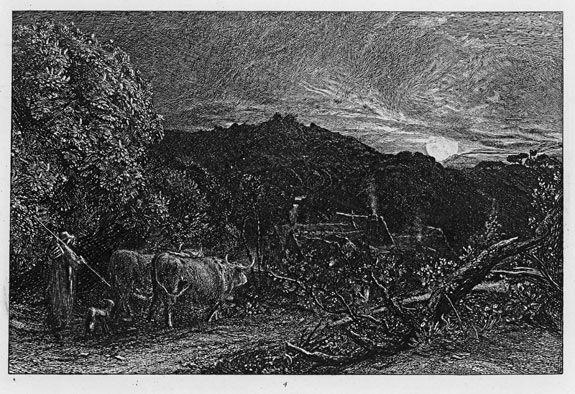|
Samuel
Palmer
(Newington,
south London 1805 – 1881 Redhill, near
Reigate, Surrey)
The
Weary Ploughman originally
known as
The Herdsman or Tardus
Bubulcus

The Weary Ploughman originally
known as The Herdsman or Tardus
Bubulcus
Alexander 8 viii/viii, Lister 8 viii/viii
192 x 263 mm (plate); 132 x 202 mm (image); 321 x 448 mm (sheet)
Etching,
1858. Published state, with the number 4 in the
lower plate border, as issued in A Selection
of Etchings by the Etching Club,
1865; total edition of 350; the only issue; comprising
300 on india paper and 50 proofs on larger paper.
On laid india paper. Occasional foxing and other
small defects in the wide margins of the support
sheet. Gilt-edged along one side. Two old tape
stains at the sheet edges verso.
Sold
|
|
Additional
Information about the Print
Palmer
carried out this plate in 1858, in a six week
period of intense, almost non-stop work. He made
copious technical notes about biting times and
procedures.
Palmer
exhibited a proof impression of The Weary Ploughman
at the Royal Academy in 1865 with the title The Ploughman Homeward Plods his Weary Way,
a quotation from Thomas Gray’s Elegy written in a Country Churchyard (1742-50),
which gives rise to the alternative Latin title
in translation of Tardus Bubulcus.
The
curfew tolls the knell of parting day,
The lowing herd winds slowly o’er the lea,
The ploughman homeward plods his weary way,
And leaves the world to darkness and to me. |
However,
though A H Palmer later would strongly deny it
as the title, it was as The Herdsman that
the image was listed and published. Lister points
out that is a more appropriate title as the oxen
show no signs of tackle and ploughing was unlikely
to have been taking place in Spring when the horse-chestnut
tree, at the left, was in flower.
It
was Griggs who came up with the title The Weary Ploughman,
complementing that of Palmer’s next plate, The Early Ploughman,
a plate of similar dimensions and composition,
but in reverse. |